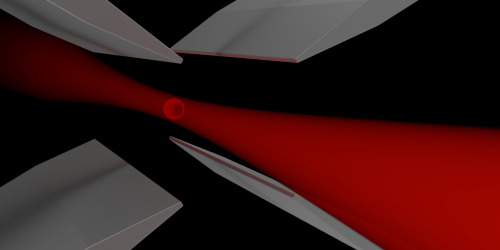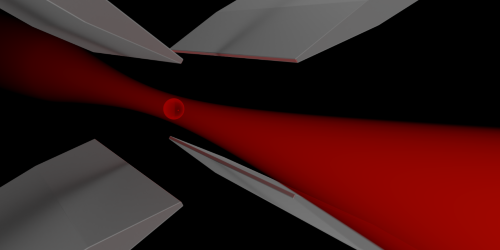Could Levitated Nanoparticles Test Spontaneous Wave-Function Collapse?
One conundrum of quantum mechanics is how a particle occupying many states snaps to a single state when measured. One theory posits that measurement has nothing to do with this “wave-function collapse,” suggesting instead that it happens spontaneously. Now, researchers have analyzed several ways one might look for spontaneous wave-function collapse using levitated nanoparticles. Though no technique is yet up to the challenge, they identify some promising avenues for investigation.
If spontaneous collapse models are correct, the wave function of a given atom collapses unbidden once every hundred million years or so. Get enough atoms together—in a nanoparticle, for example—and odds are one of their wave functions is collapsing at any moment. Thanks to the uncertainty principle, all that collapsing should slightly jostle the nanoparticle. Some researchers have proposed looking for this collapse-induced motion, but like any object, a nanoparticle moves around anyway because of the random motions of atoms in the environment. The trick is to build a device that can trap a nanoparticle and detect motion beyond what’s expected.
To see if this is possible, Andrea Vinante, of the University of Southampton, UK, and colleagues considered a hypothetical experiment where a 200-nm-wide ball of silica is levitated by electric fields in a cryogenic vacuum chamber. They calculated the performance of three tools for detecting the ball’s motion: an optical cavity, optical tweezers, and a SQUID (a superconducting device for detecting induced electrical currents).
Technical challenges prevent all of these methods from achieving the required sensitivity, the team found. If these could be overcome, both optical techniques offer greater displacement precision but at the cost of increased noise from heating the particle. SQUIDs produce much less thermal noise but have lower displacement resolution, which necessitates longer measurement times and thus greater trap stability.
This research is published in Physical Review A.
–Christopher Crockett
Christopher Crockett is a freelance writer based in Arlington, Virginia.





